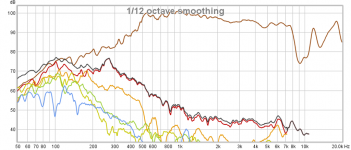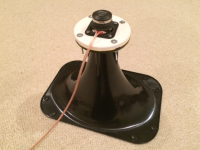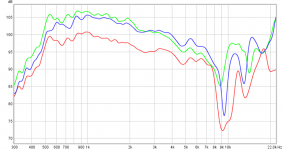Shorter Adapter
This is a 0.30 in long adapter vs. a 0.625in long one used previously. I found a mistake I made in my earlier data: the drive voltages are off because my usual data acq laptop HD died and I switched to a backup computer and forget to recalibrate the line-out voltage level relative to the amp.

This WG and FR58EX are more sensitive actually - now clocking in at 100dB at 2.83v 1m. The shorter adapter seems to have less power falloff as frequencies go higher. From 100dB at 1kHz to 93dB at 7kHz is not too bad. However the notch at 9kHz is now worse.
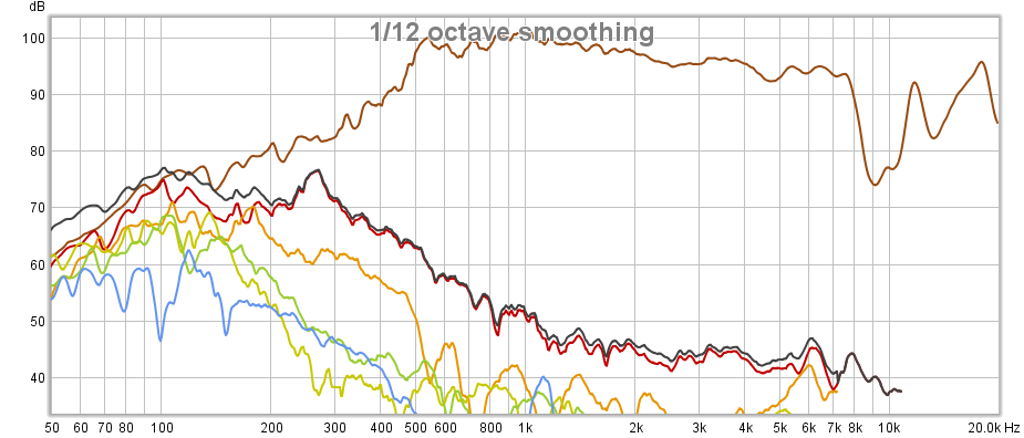
I think one of the important points Bushmeister made that I have not followed is that the profile of the WG needs to extend to driver surround. So a simple radiused roundover is to much - it needs to be a gradual increase - more complicated lofted solids will have to be used. This also means a longer adpapter will have less notching but maybe lose efficiency.
This is a 0.30 in long adapter vs. a 0.625in long one used previously. I found a mistake I made in my earlier data: the drive voltages are off because my usual data acq laptop HD died and I switched to a backup computer and forget to recalibrate the line-out voltage level relative to the amp.

This WG and FR58EX are more sensitive actually - now clocking in at 100dB at 2.83v 1m. The shorter adapter seems to have less power falloff as frequencies go higher. From 100dB at 1kHz to 93dB at 7kHz is not too bad. However the notch at 9kHz is now worse.

I think one of the important points Bushmeister made that I have not followed is that the profile of the WG needs to extend to driver surround. So a simple radiused roundover is to much - it needs to be a gradual increase - more complicated lofted solids will have to be used. This also means a longer adpapter will have less notching but maybe lose efficiency.
Attachments
Last edited:
This is a 0.30 in long adapter vs. a 0.625in long one used previously. I found a mistake I made in my earlier data: the drive voltages are off because my usual data acq laptop HD died and I switched to a backup computer and forget to recalibrate the line-out voltage level relative to the amp.

This WG and FR58EX are more sensitive actually - now clocking in at 100dB at 2.83v 1m. The shorter adapter seems to have less power falloff as frequencies go higher. From 100dB at 1kHz to 93dB at 7kHz is not too bad. However the notch at 9kHz is now worse.

I think one of the important points Bushmeister made that I have not followed is that the profile of the WG needs to extend to driver surround. So a simple radiused roundover is to much - it needs to be a gradual increase - more complicated lofted solids will have to be used. This also means a longer adpapter will have less notching but maybe lose efficiency.
Hi X and Burst and cia...
I'm sorry if I say hugue amount of wrong things and i'm sure everything i say here will be things you already know very well and much more better than me considering that I still have no experience with horns but I think much probably these dips of high frequency are manly due to reflections that cause the "cone adapter" when not are absolute progressive from start to end and well match the size of the adapter to the driver's mouth because adapter cone mouth in driver side are not big enough.
Having said that the only thing you can do to try to minimize all reflections is that the cone (the impressive and nice adapter X designed in 3D ) may be the most perfect progressive cone-shaped (constant decrease) we can build reducing its size starting the mouth of the horn with exact coupling without slot and that its initial size "exceeds by a few millimeters" to cushion driver cone at that point to prevent reflections of the edges of the driver. In other words you must create a "small" horn as perfect as possible in the part of the driver adaptation between the mouth of the horn and very important to avoid reflections at the point where the driver is attached to the piece of adaptation and for it binding mouth piece size speaker adaptation should be a bit higher in some mm to the driver cone.
I hope I explained well enough and though certainly not helped you believed it was worth the effort to try help in some way.
I love your project, especially as all you plan and you execute.
I'm still impressed with such extraordinary measures that Burst is reporting though in truth was expecting something like that because I think it can be in this project and are going to get some achievements (in quality) that may not have been seen to date in this field.
Nor should it be ruled out that the "dips" on frequency response are due only to driver problems itself, so having a good start with "anechoic" measures driver responses would greatly help to know what design problems have.
My deepest energies goes for all of you, and also my most sincere wishes luck to all
😉
I remain so tunned about this..
Cheers
Joseph
Last edited:
Jirm,
Good suggestions - thanks. I agree one of the key things is to make the transition from cone to throat so smooth and gradual that the reflection discontinuity is small.
Good suggestions - thanks. I agree one of the key things is to make the transition from cone to throat so smooth and gradual that the reflection discontinuity is small.
Here is data from two different drivers with and without throat adapter. Without the adapter, the notch is deepest. This reaffirms the requirement for as smooth of a transition from cone to throat as possible. Need to make it longer and more gradual - basically the throat is a pinch point but mild. The W2-852SH has an impressive 106.6dB sensitivity - but I can hear the distortion at lower frequencies due to excessive cone travel.
Data with short adapter for the FR58EX (red) and the W2-852SH (green), and W2-852SH clamped directly onto the WG flange (blue) using C-clampss (and a 1mm thick EVA foam gasket):
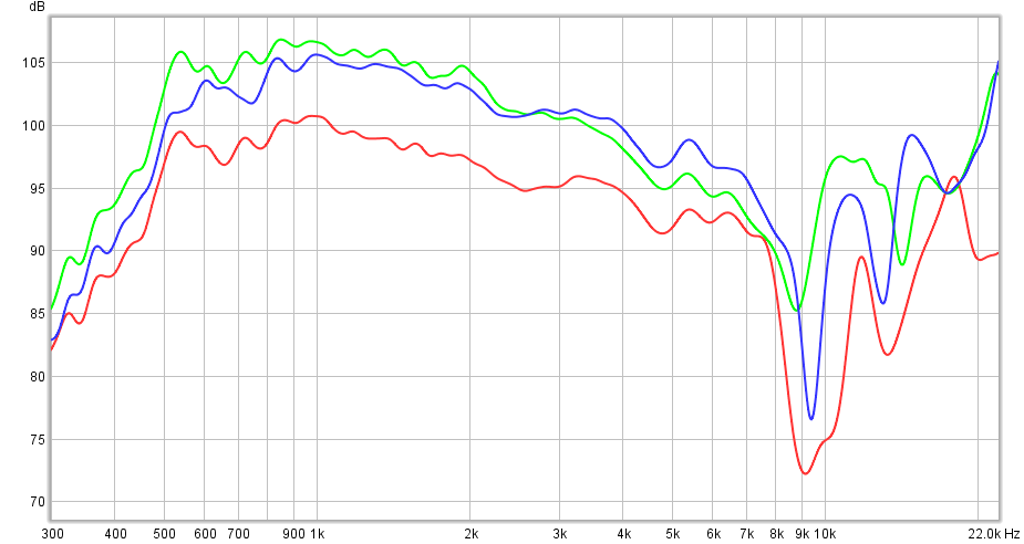
So next step is to make a taller adapter with a more complex gradual transition shape using a spline rather than a radius round over.
Data with short adapter for the FR58EX (red) and the W2-852SH (green), and W2-852SH clamped directly onto the WG flange (blue) using C-clampss (and a 1mm thick EVA foam gasket):

So next step is to make a taller adapter with a more complex gradual transition shape using a spline rather than a radius round over.
Attachments
Last edited:
This weekend, I am going to get onto fitting a woofer onto the other horn. I am desperate to hear them in stereo...
Wesayso and X - you were right, listening to some pieces of music with the flat phase and excellent step response makes a definite audible improvement - I found particularly with plucked strings and percussion. Plus I think the well behaved CD makes details much more discernible.
X - you are on the right track I believe - it is about creating a pinch point which acts like it is part of the horn. This, I believe is why my polars are so good - it has actually improved high freq dispersion.
Wesayso and X - you were right, listening to some pieces of music with the flat phase and excellent step response makes a definite audible improvement - I found particularly with plucked strings and percussion. Plus I think the well behaved CD makes details much more discernible.
X - you are on the right track I believe - it is about creating a pinch point which acts like it is part of the horn. This, I believe is why my polars are so good - it has actually improved high freq dispersion.
Hi X.
That is !
I post a so quick hand made picture (please dont laugh so much with my drawing skills 😱) triying to explain what before I say.
In addition, if possible I would try to have at least a measure of anechoic frequency response driver itself to know in advance the imperfections in the response that the driver already has by construction.
X with last data you post from two drivers im pretty sure you need remake the adapter troath to avoid the 9-10 k frecuency dip that it should not be there at least so pronounced that way.
Best wishes
That is !
I post a so quick hand made picture (please dont laugh so much with my drawing skills 😱) triying to explain what before I say.
In addition, if possible I would try to have at least a measure of anechoic frequency response driver itself to know in advance the imperfections in the response that the driver already has by construction.
X with last data you post from two drivers im pretty sure you need remake the adapter troath to avoid the 9-10 k frecuency dip that it should not be there at least so pronounced that way.
Best wishes
Attachments
Last edited:
Wesayso and X - you were right, listening to some pieces of music with the flat phase and excellent step response makes a definite audible improvement - I found particularly with plucked strings and percussion. Plus I think the well behaved CD makes details much more discernible.
Glad you liked to hear that. Yes, I do believe it to be an audible and preferable way of reproducing audio.
Is your audio stream digital? If it is, we might experiment with a bit of FIR filtering in the mix to see if we can clean up that early waterfall result I asked you to plot. Based on my own tests that too makes quite a difference.
All we would be doing is cleaning up the driver response.
This is a 0.30 in long adapter vs. a 0.625in long one used previously. I found a mistake I made in my earlier data: the drive voltages are off because my usual data acq laptop HD died and I switched to a backup computer and forget to recalibrate the line-out voltage level relative to the amp.

This WG and FR58EX are more sensitive actually - now clocking in at 100dB at 2.83v 1m. The shorter adapter seems to have less power falloff as frequencies go higher. From 100dB at 1kHz to 93dB at 7kHz is not too bad. However the notch at 9kHz is now worse.

I think one of the important points Bushmeister made that I have not followed is that the profile of the WG needs to extend to driver surround. So a simple radiused roundover is to much - it needs to be a gradual increase - more complicated lofted solids will have to be used. This also means a longer adpapter will have less notching but maybe lose efficiency.
X Here a K-tube after 8 Khz? with a compression driver afcourse making a very nice high sensitivity horn?,
X Here a K-tube after 8 Khz? with a compression driver afcourse making a very nice high sensitivity horn?,
That solution is called: giving up 🙂 or cheating even!
Bushmeister showed us it isn't required...
Last edited:
X Here a K-tube after 8 Khz? with a compression driver afcourse making a very nice high sensitivity horn?,
This is another build type.
I igree that Burns and X (with his xTrynergy build) showed that is possible to make a really superb horn without need of compression driver.
FAST mixed with Sinergy and a horn without compression driver.
Well i think here they are giving birth first real Unicorn on history of world 😀
And that Unicorn can sing better as no one ever did before.
Maybe I'm too much excited but I really love this project by the possibilities I see in it.
Regards
Yes I now I have to post it on the trynergy part.
For me, I do NOT use digital corrections, all is analog, even the delays allpass, so it more difficult for me.
I like analog systems. But before I give up I do go on with that idea of a damped throat adaptor, I make a new one for the horn and go from square to round, I did already test a little with that but need a new one to get foam under the surround.
I do go on with that idea of a damped throat adaptor, I make a new one for the horn and go from square to round, I did already test a little with that but need a new one to get foam under the surround.
I post on trynergy threat in future, because you are right, this is a whole other part, I also make a horn who go from 80 hz and up with a K-tube without the need for bass units on it, I go draw now in sketchup.
regards
For me, I do NOT use digital corrections, all is analog, even the delays allpass, so it more difficult for me.
I like analog systems. But before I give up
 I do go on with that idea of a damped throat adaptor, I make a new one for the horn and go from square to round, I did already test a little with that but need a new one to get foam under the surround.
I do go on with that idea of a damped throat adaptor, I make a new one for the horn and go from square to round, I did already test a little with that but need a new one to get foam under the surround.I post on trynergy threat in future, because you are right, this is a whole other part, I also make a horn who go from 80 hz and up with a K-tube without the need for bass units on it, I go draw now in sketchup.
regards
And now some questions from the neophyte 🙂
I've read the entire thread up to here
This sounds like a fascinating build and one the Soldermizer should attempt. Ah, but dare he try his usual half-assed shortcuts? Maybe. Or wait for a consensus build to emerge?
Some questions: must a pre-made horn be used? I'm aware that several types of horn exist, why not a rectangular one? If this is doable, wouldn't it make the throat adaptor for the full range easier? Many if not most "midranges" have a square mounting profile. Must the throat be round to match the driver's shape?
This is fascinating stuff, I am likely to buy some drivers to "muck about" with...
I've read the entire thread up to here

This sounds like a fascinating build and one the Soldermizer should attempt. Ah, but dare he try his usual half-assed shortcuts? Maybe. Or wait for a consensus build to emerge?
Some questions: must a pre-made horn be used? I'm aware that several types of horn exist, why not a rectangular one? If this is doable, wouldn't it make the throat adaptor for the full range easier? Many if not most "midranges" have a square mounting profile. Must the throat be round to match the driver's shape?
This is fascinating stuff, I am likely to buy some drivers to "muck about" with...
1) Sure, but expect half-assed results ;^).I've read the entire thread up to here
This sounds like a fascinating build and one the Soldermizer should attempt.
1)Ah, but dare he try his usual half-assed shortcuts?
2)Or wait for a consensus build to emerge?
3)Some questions: must a pre-made horn be used?
4)I'm aware that several types of horn exist, why not a rectangular one?
5)If this is doable, wouldn't it make the throat adaptor for the full range easier?
6) Many if not most "midranges" have a square mounting profile. Must the throat be round to match the driver's shape?
2) You might decide what your goals are before choosing the "consensus".
3) No, the Maltese horns ( posts #319, 321, 323, 343) using the TC9 could be built fairly easily, but are quite long and narrow dispersion. They load well down to 250 Hz, about an octave below the other horns tried by Bushmeister and xrc in this thread.
4) Nothing wrong with a rectangle as a horn mouth shape.
5) No, rectangular to round requires a bit more work than round to round.
6) Not required, but for uniform polar response to 16kHz the driver cone and surround profile, diameter and throat to horn transition area are very critical of small changes. Remember, a 500 Hz wavelength is 2.26 feet, but 5000 Hz is only 2.7 inches, small details are 10 times (an order of magnitude) more important.
See point #1...
Art
Last edited:
Just been thinking a little about this throat cancellation notch... Keeping in mind that I have little experience with horns, would having a multi-cellular type entrance into the horn have any benefits? You'd probably shift the notch considerably higher in frequency where it would be a lot less noticeable, but not sure what other trade offs this would introduce.
Would need to keep the length of the multicellular part before the band pass injection I think, and that may be the trade off perhaps, in that it may skew the band pass response. But it may be an easy trial to just cut a profiled cross to fit in the throat and near the cone to give a quartered throat and move the notch near 18khz?
Maybe someone with more experience could weigh in?
Would need to keep the length of the multicellular part before the band pass injection I think, and that may be the trade off perhaps, in that it may skew the band pass response. But it may be an easy trial to just cut a profiled cross to fit in the throat and near the cone to give a quartered throat and move the notch near 18khz?
Maybe someone with more experience could weigh in?
Last edited:
Shame no-one has tried using similar set up. 🙁
I actually thought this was the project, using that horn and those drivers, so I am acquiring the parts for your build, with the horns on hand. Whether I have the skill to complete the project ... well, we'll have to see. Looks like a terrific result.
Finally some progress - SB65 is the key
After many tests with a short (0.30in), medium (0.625in), and long (1.00in) throat adapters with the FR58EX, I could not get the 9kHz dip to go away. I should have realized it probably was a cone resonance thing going on as the impulse just looked horrid.
Finally, switched to the SB65 in the medium adapter using a simple foam core gasket to keep the surround from bumping the adapter and the results looked promising as the 9kHz dip went away. The gasket was a bit small so the surround was rubbing the gasket at lower frequencies and causing the distortion to really increase.
Here is a photo of the SB65 as mounted to the long adapter on the Faital Pro LTH142 wave guide:
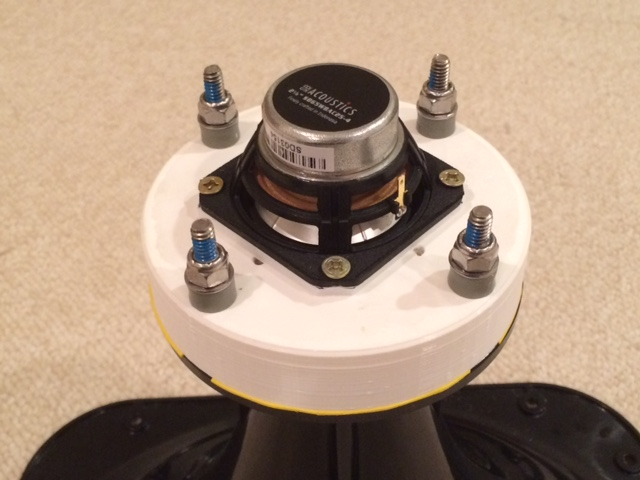
Here is a model of the long thhroat adapter so you can see the profile:
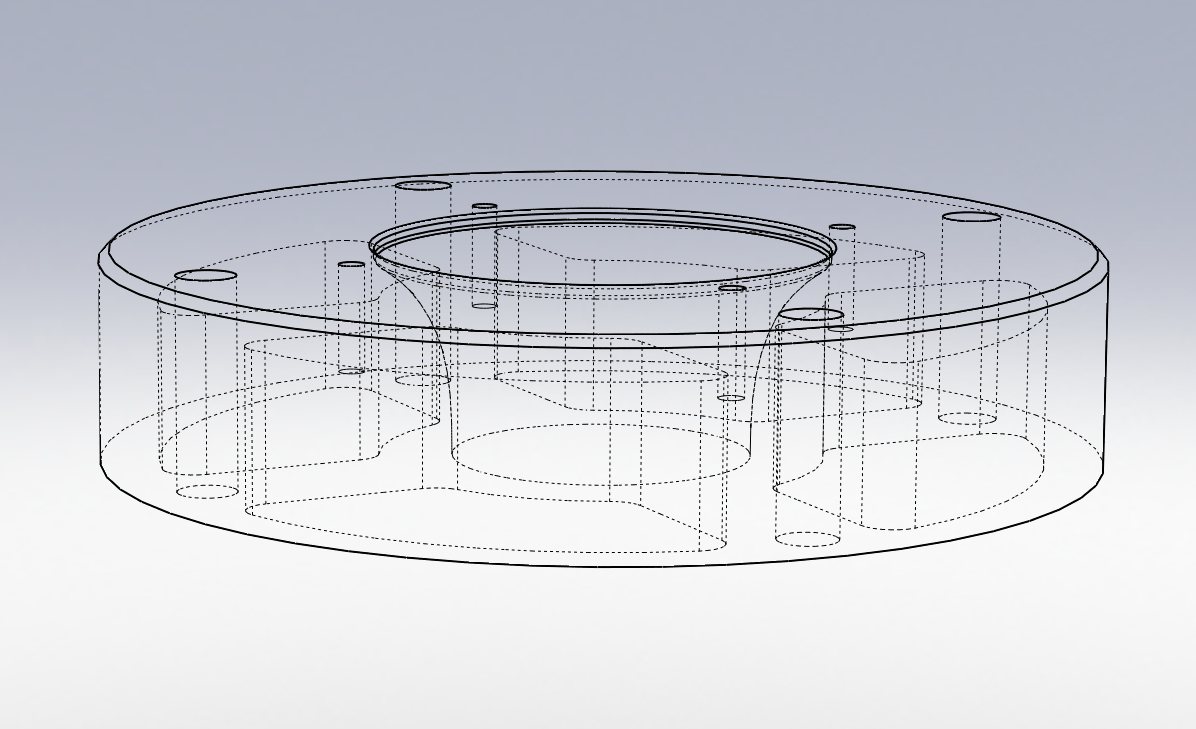
Here is a comparison of the various throat adapters, there is still a small dip near 9kHz, but it's only 5dB, and when viewed in frequency dependent gating at 1/6th octave, the dip is not there:
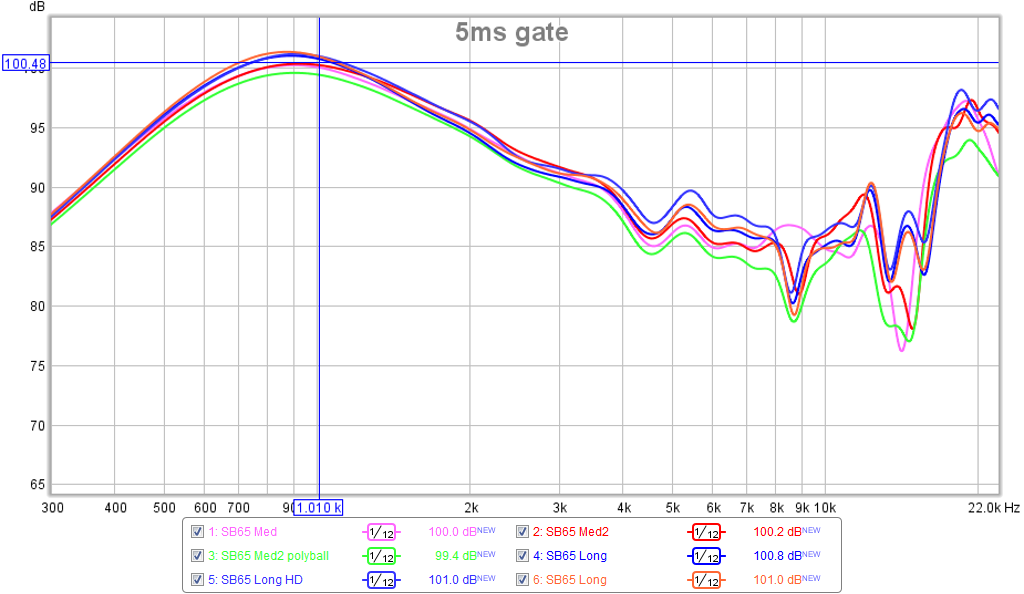
I then switched to the long throat for the remainder of the measurements. The long throat adapter uses a gentle spline curve rather than a radius, I also made a new gasket so the surround doesn't rub, and the test shows it has the smoothest performance and best looking phase. The phase, although not flat, is well behaved and once some PEQ is applied, I expect it to flatten out substantially:
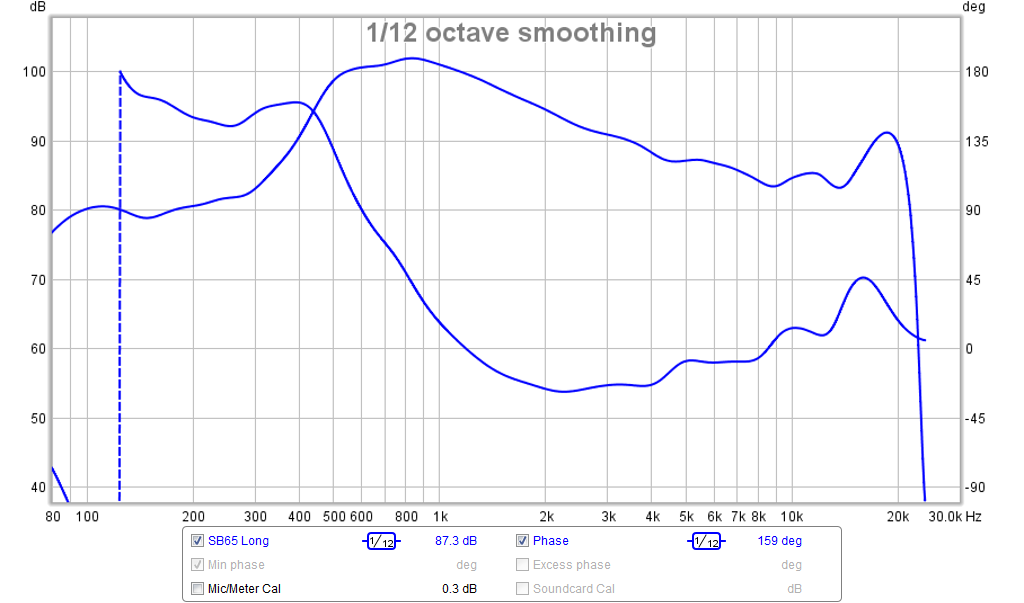
Here is the harmonic distortion of the SB65 at -6dB from 2.83v at 0.5m:
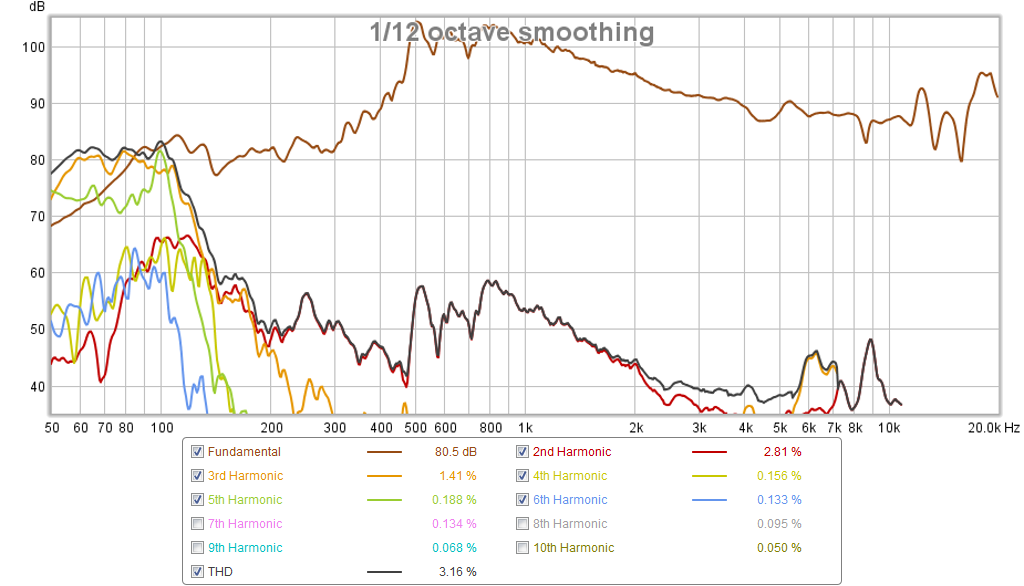
Here is the harmonic distortion measured at 1m, and -5dB down from 2.83v (the cursor was on some random spot, the THD at 1kHz at 97dB was about 0.5%):
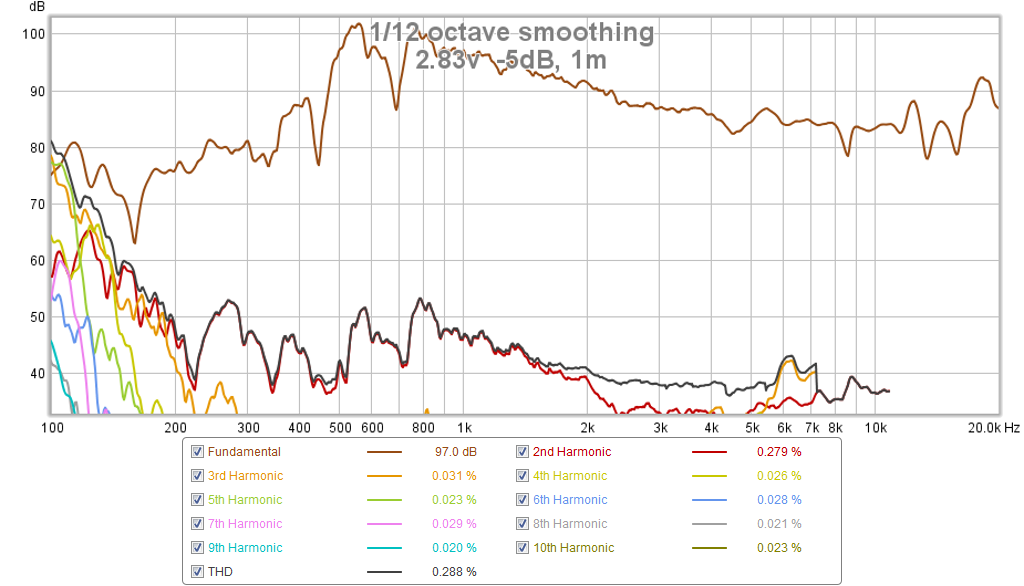
Here is the RTA looking at a 1kHz sine wave to see the distortion components with horn playing at 100dB (be sure to wear ear plugs when testing):
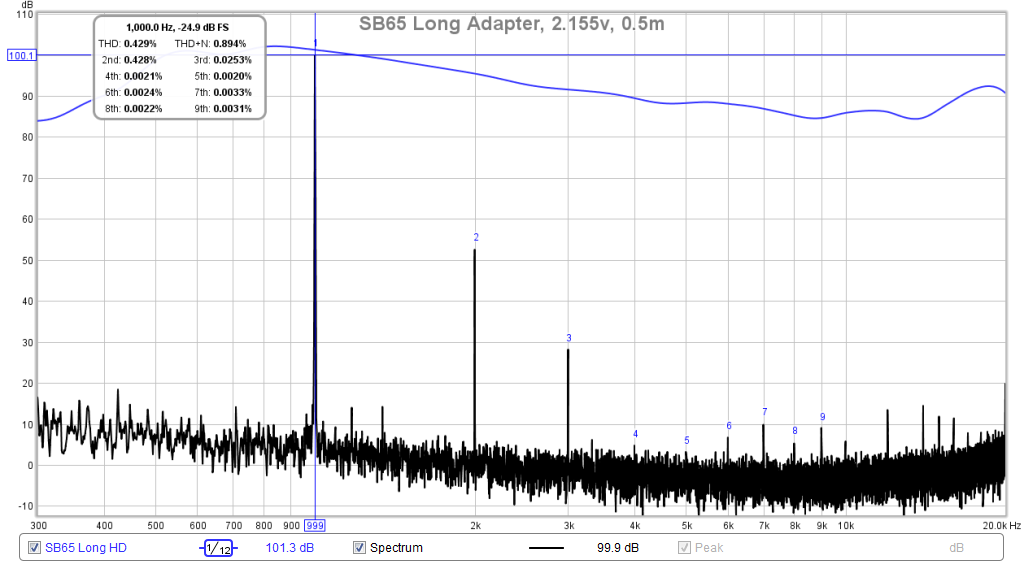
Here is the impulse response of the SB65 with the long adapter:
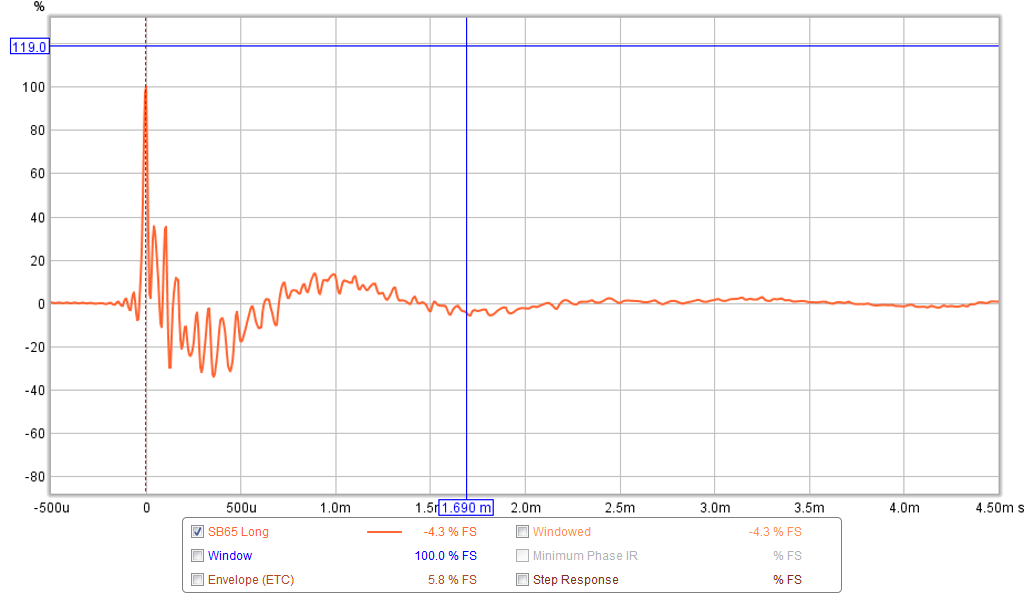
After many tests with a short (0.30in), medium (0.625in), and long (1.00in) throat adapters with the FR58EX, I could not get the 9kHz dip to go away. I should have realized it probably was a cone resonance thing going on as the impulse just looked horrid.
Finally, switched to the SB65 in the medium adapter using a simple foam core gasket to keep the surround from bumping the adapter and the results looked promising as the 9kHz dip went away. The gasket was a bit small so the surround was rubbing the gasket at lower frequencies and causing the distortion to really increase.
Here is a photo of the SB65 as mounted to the long adapter on the Faital Pro LTH142 wave guide:

Here is a model of the long thhroat adapter so you can see the profile:

Here is a comparison of the various throat adapters, there is still a small dip near 9kHz, but it's only 5dB, and when viewed in frequency dependent gating at 1/6th octave, the dip is not there:

I then switched to the long throat for the remainder of the measurements. The long throat adapter uses a gentle spline curve rather than a radius, I also made a new gasket so the surround doesn't rub, and the test shows it has the smoothest performance and best looking phase. The phase, although not flat, is well behaved and once some PEQ is applied, I expect it to flatten out substantially:

Here is the harmonic distortion of the SB65 at -6dB from 2.83v at 0.5m:

Here is the harmonic distortion measured at 1m, and -5dB down from 2.83v (the cursor was on some random spot, the THD at 1kHz at 97dB was about 0.5%):

Here is the RTA looking at a 1kHz sine wave to see the distortion components with horn playing at 100dB (be sure to wear ear plugs when testing):

Here is the impulse response of the SB65 with the long adapter:

Attachments
-
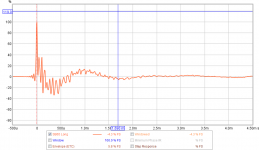 LTH142-SB65-Long-adapter-GOOD-IR-f6.png59.2 KB · Views: 850
LTH142-SB65-Long-adapter-GOOD-IR-f6.png59.2 KB · Views: 850 -
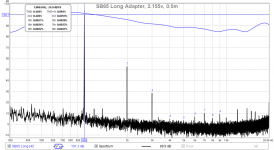 LTH142-SB65-Long-adapter-GOOD-RTA-1k-100dB-f5.png87.5 KB · Views: 840
LTH142-SB65-Long-adapter-GOOD-RTA-1k-100dB-f5.png87.5 KB · Views: 840 -
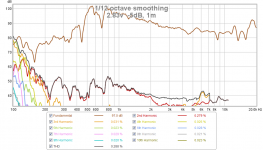 LTH142-SB65-Long-adapter-GOOD-HD-96dB-1m-f4.png123.3 KB · Views: 832
LTH142-SB65-Long-adapter-GOOD-HD-96dB-1m-f4.png123.3 KB · Views: 832 -
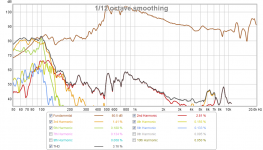 LTH142-SB65-Long-adapter-GOOD-HD-f3.png127.4 KB · Views: 851
LTH142-SB65-Long-adapter-GOOD-HD-f3.png127.4 KB · Views: 851 -
 LTH142-SB65-Long-adapter-GOOD-Phase-f2.png66.9 KB · Views: 872
LTH142-SB65-Long-adapter-GOOD-Phase-f2.png66.9 KB · Views: 872 -
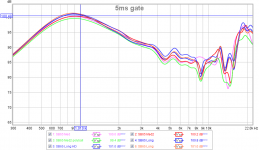 LTH142-SB65-Long-adapter-GOOD-freq-5ms-gate-f0.png105.7 KB · Views: 853
LTH142-SB65-Long-adapter-GOOD-freq-5ms-gate-f0.png105.7 KB · Views: 853 -
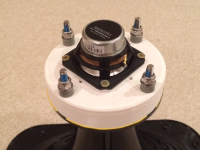 SB65-Long-Adapter-photo.png391.8 KB · Views: 19,300
SB65-Long-Adapter-photo.png391.8 KB · Views: 19,300 -
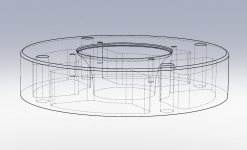 Xbush-Throat-Adapter-v3-wireframe.PNG228.2 KB · Views: 19,683
Xbush-Throat-Adapter-v3-wireframe.PNG228.2 KB · Views: 19,683
Last edited:
Well done X!!!
So glad you have taken the same road and confirmed all my findings!
I have just started the process to mount a second woofer to my horn, so soon we will see what can be achieved with another!
So glad you have taken the same road and confirmed all my findings!
I have just started the process to mount a second woofer to my horn, so soon we will see what can be achieved with another!
I actually thought this was the project, using that horn and those drivers, so I am acquiring the parts for your build, with the horns on hand. Whether I have the skill to complete the project ... well, we'll have to see. Looks like a terrific result.
Well I hoped people would follow the same road as me - but it seems most have chosen different horn/driver combinations.
I was getting worried everyone would run into problems and the original concept I am trying to build would get somewhat lost!
- Home
- Loudspeakers
- Multi-Way
- A Bookshelf Multi-Way Point-Source Horn
